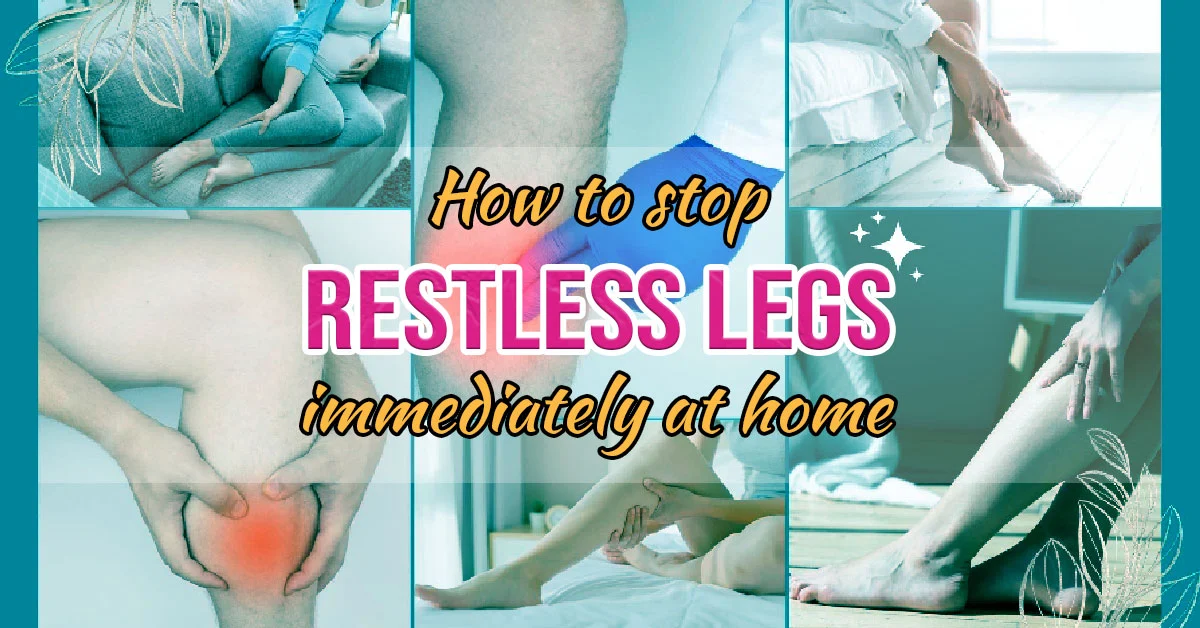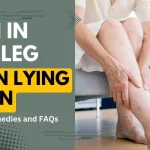Restless legs syndrome (RLS) is a common condition that causes unpleasant sensations in the legs and an uncontrollable urge to move them. The symptoms usually occur in the evening when sitting or lying down and can significantly disrupt sleep. Fortunately, there are several effective home remedies that can provide immediate relief. In this article we will explore How to Stop Restless Legs Immediately at Home and its causes and home remedies.
Causes of Restless Legs
The exact cause of RLS is unknown, but it is associated with the following factors:
Iron deficiency
Low iron levels affect nerve function and can trigger RLS symptoms. This is common in those with anemia.
Pregnancy
RLS occurs in up to 30% of pregnant women, especially in the last trimester. Hormonal changes and low iron are contributing factors.
Chronic diseases
Kidney failure, diabetes, and peripheral neuropathy are linked to a higher risk of RLS.
Medications
Some antidepressants, antihistamines, and calcium channel blockers can worsen or trigger RLS.
Genetics
RLS has a strong familial link and variants in several genes are associated with the condition.
Alcohol and caffeine
These stimulants can exacerbate symptoms of RLS temporarily.
Home Remedies to Stop Restless Legs Immediately
1. Stretch and massage
Stretching helps relax the leg muscles, while massage increases circulation. Try:
- Calf stretches against a wall for 30 seconds on each leg.
- Hamstring stretches by putting your leg up on a chair and leaning forward. Hold for 30 seconds.
- Massaging your calves and thighs using circular motions with your hands.
- Using a foam roller on your legs for 5 minutes before bedtime.
2. Hot or cold therapy
Heat helps improve circulation while cold numbs nerves. Options include:
- Taking a warm bath for 15-20 minutes. Add Epsom salts or essential oils like lavender.
- Placing a heating pad or hot water bottle on your legs for 10-15 minutes.
- Wrapping a bag of frozen vegetables or ice pack in a towel and applying to legs for 10 minutes.
- Alternating hot and cold therapy by taking a warm shower then briefly switching water to cold.
3. Light exercise
Light physical activity helps reduce restless sensations and relax the muscles. Try:
- Going for a short 10 minute walk.
- Doing calf raises, leg swings, or other simple standing exercises.
- Stretching your legs by doing yoga poses like the forward bend or child’s pose.
- Sitting on an exercise ball instead of a chair and gently bouncing your legs.
4. Magnesium-rich foods
Magnesium deficiency exacerbates RLS. Boost your levels by eating magnesium-rich foods before bedtime such as:
- Almonds, cashews, pumpkin seeds.
- Dark leafy greens like spinach and kale.
- Avocados, edamame, black beans.
- Bananas, figs, and dark chocolate.
You can also take a magnesium supplement daily with your doctor’s approval.
5. Relaxation techniques
Stress and anxiety worsen RLS symptoms. Try:
- Taking a warm bath with epsom salts and essential oils like lavender.
- Listening to calming music or white noise before bedtime.
- Practicing deep breathing exercises. Inhale slowly, hold for 5 seconds, and exhale fully.
- Trying meditation or yoga to quiet the mind. Even 5 minutes can help relax the body.
- Massaging your legs with calming lotion using light, stroking motions.
6. Apply topical menthol
Menthol is a natural compound with a cooling sensation that can temporarily relieve restless legs. Options include:
- Products like Biofreeze or IcyHot containing menthol. Apply a small amount to legs.
- Making a DIY mixture of 2 parts coconut or olive oil and 1 part peppermint oil. Massage onto legs.
- Using menthol-containing lotions or muscle creams following label instructions.
7. Stay hydrated
Dehydration exacerbates RLS symptoms. Be sure to drink plenty of water and avoid alcohol and caffeine which have diuretic effects. Some ways to boost hydration:
- Drink a glass of water upon waking and before bedtime.
- Carry a water bottle and take frequent sips throughout the day.
- Eat water-rich foods like cucumbers, watermelon and berries.
- Add lemon, mint or fruit to water for flavor and drink herbal caffeine-free teas.
8. Optimize sleep hygiene
Proper sleep habits reduce symptoms. Recommendations include:
- Going to bed and waking up at the same time daily.
- Limiting afternoon naps to 30 minutes.
- Avoiding screens and stimulating activities before bedtime.
- Making sure your legs and blankets are warm but not hot while sleeping.
- Using a white noise machine or humidifier if environmental noises disturb sleep.
9. Avoid triggers
Identify and limit or avoid foods, activities and medications that worsen RLS such as:
- Alcohol, tobacco and caffeinated drinks.
- Strenuous evening exercise.
- Anti-nausea, antipsychotic or antidepressant medications.
- Food additives like MSG.
When to See a Doctor
See your doctor if lifestyle measures don’t relieve restless legs or symptoms severely disrupt sleep or daily life. The doctor may check for underlying conditions like anemia and recommend:
- Blood tests to check for iron, vitamin and mineral deficiencies.
- Medications like pramipexole, gabapentin or opioids in severe cases.
- Compression stockings to improve circulation.
- Referral to a sleep specialist for evaluation of conditions like sleep apnea.
- RLS medication should only be taken under a doctor’s supervision due to side effects.
Home Remedies for Restless Legs – The Bottom Line
The unpleasant sensations of restless leg syndrome can be managed with self-care and home remedies such as hydration, heat and cold therapy, exercises, magnesium-rich foods, menthol rubs, and relaxation techniques. Avoiding triggers like alcohol and optimizing sleep habits also helps provide relief. Speak to your doctor if symptoms persist or significantly affect sleep and quality of life. While restless legs can’t always be cured, lifestyle measures can effectively provide symptom relief and let you rest easy.
Frequently Asked Questions
1. Why do my legs feel twitchy and uncomfortable at night?
Twitchy, uncomfortable legs at night are classic symptoms of restless legs syndrome (RLS). The exact cause is unknown but it is related to nerve dysfunction and problems with dopamine signaling in the brain.
2. Do restless legs ever go away permanently?
For many people, RLS symptoms come and go over time. However, the condition is chronic for some and requires long-term management. Avoiding triggers and using home remedies can relieve symptoms during flare ups.
3. How can I fall asleep if my legs keep twitching?
It’s challenging to fall asleep when legs feel restless. Try relaxation techniques before bedtime like massage, warm baths and meditation. Optimizing sleep hygiene, exercising earlier in the day, and avoiding caffeine can also help minimize symptoms at night.
4. Can magnesium supplements help restless legs?
Yes, magnesium supplements often help reduce RLS symptoms and cramping by improving nerve transmission and muscle relaxation. Take 250-400 mg daily with your doctor’s consent, along with eating magnesium-rich foods.
5. Should I see a doctor for restless legs?
See your doctor if restless legs persist for over 2 weeks and disrupt sleep or daily life. A physician can check for underlying conditions like anemia, recommend appropriate lifestyle measures, and prescribe medications if appropriate to manage severe symptoms.
6. What foods make restless legs worse?
Foods that can exacerbate restless legs include caffeine, alcohol, chocolate, MSG, aspartame, sugars, and salty snacks. Avoiding these triggers, staying hydrated, and opting for magnesium-rich foods can help reduce symptoms.
7. What essential oils are good for restless legs?
Some essential oils help promote relaxation and circulation in restless legs. Good options include lavender, marjoram, geranium, Roman chamomile, clary sage, rosemary, cinnamon and peppermint oils. Mix with a carrier oil and massage into legs.
8. Is walking good for restless legs?
Light walking is an excellent home remedy for restless legs as it reduces sensations, relieves muscle tension, and promotes relaxation. Take a short 10 minute walk before bedtime or try calf raises and leg swings to help restless legs.
9. How can I stay hydrated to improve restless legs?
Drink plenty of water, herbal tea, and fluids containing electrolytes throughout the day. Consume water-rich fruits and vegetables which provide hydration. Limit caffeine and alcohol which have diuretic effects and can dehydrate you further.
10. Should I wear compression socks for restless legs?
Compression socks can help some people with RLS by improving circulation in the legs and increasing comfort. Try wearing them during the day or while sleeping. Speak to your doctor about proper compression stocking fit and usage recommendations.
It’s also important for you: Leg Pain Without Swelling or Redness




1 thought on “How to Stop Restless Legs Immediately at Home”